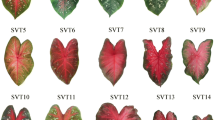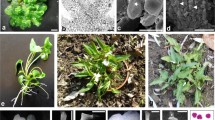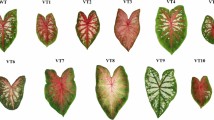Abstract
Somaclonal variant plants may be of use in broadening the germplasm base of plant species and providing useful stocks for cytogenetic investigations. This study was conducted to compare morphologic, cytogenetic and enzymatic characteristics of 21 R1 (initial regenerate) bluestem,Bothriochloa sp., plants, visibly identified in a field-grown population of 522 plants as probable variants, with their respective R0 (explant donor) progenitor. An R2 seedling population was grown to ascertain the transmission of the variant R1 phenotypes. All R1 plants differed from their respective R0 progenitors in one or more morphological characters. Foliage colour was the most pronounced difference in most cases. Four of the plants, three of which were dwarfed, produced no inflorescences. The R1 plants tended to be shorter than R0 progenitors and had corresponding decreases in lengths on inflorescences and lowest racemes. All R1 plants of accessions 8911C and 8793 had an increase in chromosome number from2n=4x=40 to2n=5x=50. Three dwarfed R1 plants, derived from accession 8873B, were aneuploids, two having2n=48 chromosomes and the third being a probable mixoploid with 55–58 chromosomes. Other plants of accession 8873B had the R0 chromosome number. Fertility, as estimated by pollen stainability and seed set, generally was reduced in R1 plants relative to the R0. This reduction was not drastic, however, with all flowering plants having 45% or higher seed set. Apomixis apparently maintained fertility in all R1 plants, including those with a pentaploid chromosome number. All R1 plants differed from their respective R0 plants in peroxidase and esterase banding patterns. All R1 plants of accessions 8911C, and 8793, respectively, had identical peroxidase and esterase bands. For both enzyme systems two banding patterns were present in R1 plants of accession 8873B, with 12 of 13 plants exhibiting common patterns. Examination of R2 progeny plants confirmed the genetic transmission of the variant phenotypes and, by virtue of uniformity, indicated apomictic reproduction in the R1 plants. The results demonstrate the production of potentially useful genetic and cytogenetic variant plants via tissue culture in these apomictic species.
Similar content being viewed by others
References
Armstrong CL, Phillips RL (1988) Genetic and cytogenetic variation in plants regenerated from organogenic and friable embryogenic tissue cultures of maize. Crop Sci 28: 363–369
Brettell RIS, Dennis ES, Snowcroft WR, Peacock WJ (1986) Molecular analysis of a somaclonal mutant of maize alcohol dehydrogenase. Mol Gen Genet 202: 235–239
Brettell RIS, Pallotta MA, Gustafson JP, Appels R (1986) Variation at the Nor loci in triticale derived from tissue culture. Theor Appl Genet 71: 637–643
Chaleff RS (1983) Isolation of agronomically useful mutants from plant cell cultures. Science 219: 676–682
Cullis CA, Cleary W (1985) DNA variation in flax tissue culture. Can J Genet Cytol 28: 247–251
De Paepe R, Prat D, Hugnet T (1983) Heritable nuclear DNA changes in doubled haploid plants obtained by pollen culture ofNicotiana sylvestris. Plant Sci Lett 28: 11–28
Gill BS, Kam-Morgan LVW, Shepard JF (1987) Cytogenetic and phenotypic variation in mesophyll cell-derived tetraploid potatoes. J Hered 78: 15–20
Groose RW, Bingham ET (1986) An unstable anthocyanin mutation recovered from tissue culture of alfalfa (Medicago sativa). 1. High-frequency reversion upon reculture. Plant Cell Rep 5: 104–107
Hanna WW, Lu C, Vasil IK (1984) Uniformity of plants regenerated from somatic embryos ofPanicum maximum Jacq. (Guinea grass). Theor Appl Genet 67: 155–159
Hicks PH, Sleper DA, Randall DD, Crane CF (1982) Peroxidase isozyme differences in tall fescue cultivars and allopolyploid accessions. Euphytica 31: 175–181
Kornerup A, Wanscher JH (1962) Reinhold Color Atlas. Reinhold Publ Co, New York
Landsmann J, Uhrig H (1981) Somaclonal variation inSolanum tuberosum detected at the molecular level. Theor Appl Genet 71: 500–505
Larkin RJ, Snowcroft WR (1981) Somaclonal variation-a novel source of variability from cell cultures for plant improvement. Theor Appl Genet 60: 197–214
Metzinger BD, Taliaferro CM, Johnson BB, Mitchell EDJr (1987) In vitro regeneration of apomictic bluestem grasses. Plant Cell Tissue Organ Culture 10: 31–38
Morrish F, Vasil V, Vasil IK (1984) Developmental morphogenesis and genetic manipulation in tissue and cell cultures of the Gramineae. In: Scandalias JG (Ed) Molecular Genetics of Development-Advances in Genetics 24 (p 431–499) Academic Press Inc., New York
Ogura H (1976) The cytological chimeras in original regenerates from tobacco tissue cultures and in their offsprings. Jap J Gen 51: 161–174
Ornstein L, Davis BJ (1962) Disc Electrophoresis (Parts I and II) Distillation Products Industries, Rochester, New York
Orton TJ (1984) Somaclonal variation: Theoretical and practical considerations. In: Gustafson JP (Ed) Gene Manipulation in Plant Improvement (p 427–469) Plenum Press, New York
Shaw RC, Prasad R (1970) Starch gel electrophoresis of enzymes. A compilation of recipes. Biochem Genet 4: 297–320
Author information
Authors and Affiliations
Rights and permissions
About this article
Cite this article
Taliaferro, C.M., Dabo, S.M., Mitchell, E.D. et al. Morphologic, cytogenetic, and enzymatic variation in tissue culture regenerated plants of apomictic old-world bluestem grasses (Bothriochloa sp.). Plant Cell Tiss Organ Cult 19, 257–266 (1989). https://doi.org/10.1007/BF00043352
Received:
Accepted:
Issue Date:
DOI: https://doi.org/10.1007/BF00043352




